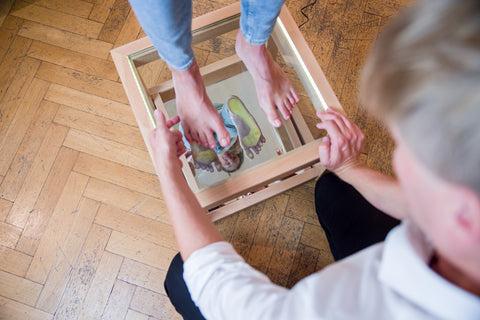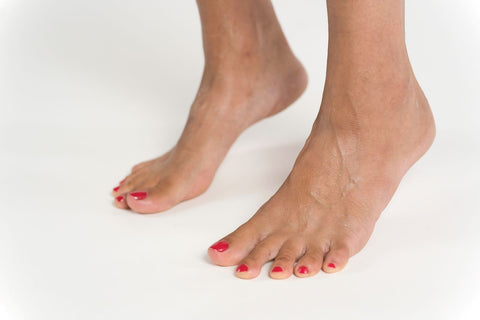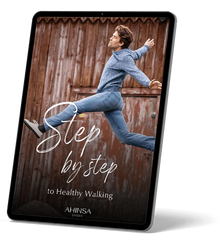A high instep isn’t (necessarily) the problem. 5 tips for shoes that will fit you
We know that story well. That's what living with a high instep is like. Fortunately, we have good news: High insteps don't have to be a health problem. And finding shoes that fit right is easy when you know a few basic tips.
Don’t believe it? You'll be surprised by the shoes we've found for your high-instep foot.
What is a high instep? And is it really such a problem?
The human foot has a natural arch that provides cushioning while walking. Some of us have a less distinct arch, which we refer to as flat feet or fallen arch. And some have a higher arch: which we refer to as a high instep.
There’s no chart that can reliably determine how many centimeters makes a “high” instep.
But, unlike a flat foot, a high instep is not a problem in itself. As physiotherapist Lukáš Klimpera says: "It’s not a problem if the foot is functional and it senses and adapts to the terrain."
The real problem occurs when the foot is stiff and can’t handle natural movement.

The important thing is that the feet are working. They're flexible, mobile and can react to the terrain.
Pes cavus – when a high instep hurts
The extreme form of a high instep is called pes cavus. It's easy to recognize by a person’s footprint. The imprint of a high-instep won’t show the outer side of the foot.
That means you're only stepping down on your toes and heels.
The muscles in a high-instep foot are in great tension. The arch doesn't provide cushioning, which means you’re stepping down hard on your toes and heel. You’re overloading them, which can lead to other problems such as hammer toes or heel spurs.
So what are the symptoms of a high-instep foot?
- Pain when walking
- Pain after long walks
- Stiff feet
- Toe deformation
How do I know if I have a high instep?
You might be expecting a chart with clear data, where upwards of so many centimeters means a high instep. Unfortunately, no such chart exists.
But you probably know yourself that your shoes are often constricting you at your instep – that means your instep is higher than others.
The important question is: How do I know if my high instep is problematic?
Try this exercise. Stand with your feet on the floor and first curl your toes in back towards your heel, then pull your heel towards your toes. Is that working, or is your foot too stiff? If you feel tension and can't get your foot moving, see a physiotherapist.
What causes high insteps? Genetics, and the wrong shoes
People think they must have been born with high insteps. But that’s not necessarily true. Yes, a higher instep can be congenital, but we ourselves are also often to blame.
"A high instep can occur when the toes can’t function and the foot arches to compensate for it," says physiotherapist Lukáš Klimpera.
What do your shoes look like? If they're classic sneakers, pumps or formal shoes, you've just found the root of the problem.
Ordinary shoes are too narrow for the human foot. They bind the toes together and deprive them of their proper function. But we humans need our toes to walk. When we aren’t using them, we find different ways to walk. And a high instep may be one way we compensate for the inactivity of our toes.

Healthy shoes have a wide toe box – like these. If yours don't, they’re depriving your toes of their proper function.
How to choose shoes for high insteps? Practical advice and 5 tips for shoes that fit
Focus on getting your feet to function naturally in your shoes. Look for shoes with a wide toe box and flexible materials that copy the movement of your foot.
These tips will help you choose shoes that fit you perfectly the first time you put them on.
➡️ Sneakers are a sure bet. Try ones with mesh
You can tighten or loosen sneakers at the instep to suit your needs. This is ideal for high insteps!
For us, sneakers made of flexible mesh have proven to be particularly beneficial. The mesh stretches and adapts to your needs.
➡️ Laces indicate comfortable shoes for a high instep
Laces = shoes that are adaptable. So especially for winter, look for shoes with laces. But be careful, the lacing should start at the instep, or better yet, just above the toes.
➡️ Sandals yes, but adjustable ones
You probably already know just how hard it is to find sandals with straps for a high instep. Avoid ones that have a strap right across the instep or from toe to ankle.
You’re better off looking for sandals that are adjustable. Like Hava sandals, which you can adjust over your toes and around your ankle to fit your needs. If you’re left with excess strap, just cut it off – it won’t fray.
Or get sandals that you can tie on to fit your needs. Like these ribbon sandals.
Head outdoors in Verso sandals, which have several different fastening options and can be tightened to adapt to your foot.
➡️ Rubber and flexible materials will fit you
The softer and more flexible the material, the better. So try elastic straps. Suna sandals, for example, fit any instep thanks to the textile rubber.
➡️ Ballet flats look good on everyone
Ballet flats have one big advantage: they’re loose over the instep, and that's why they’ll fit you. These are fastened with a strap that you can adjust.
Extra tip: Check the size chart. We've added instep dimensions to all Ahinsa shoes.
Need shoes with arch support?
A high-instep foot has an over-average arch. It needs relaxation, not support. That’s why you should look for shoes in which the foot functions naturally instead of orthopaedic shoes with arch support. Make sure they have:
- a wide toe box
- anatomical shape
- flexible materials that copy your movement
How do you measure the instep to make sure the shoes will fit?
All you need is a tailor's tape measure. Measure the circumference of the foot at its widest point. Our size charts list the circumference of the instep for this point.
Some manufacturers might indicate the circumference/height of the instep in different ways. That’s why we recommend checking their size charts, which should list how they measure the instep.
How is a high instep treated? Primarily with exercise
How can you get rid of a high instep? If your foot is functional, flexible and can adapt to the terrain, you probably don't need treatment. You don't actually need to get rid of it.
However, if you’re suffering from pain or other problems, make an appointment with a physiotherapist or orthopedist.
A specialist will examine you using a podoscope and recommend treatment. They’ll probably recommend exercises to relax the high-instep foot, get the foot moving and engage it with the whole leg.
You can also try exercises at home. They won’t replace going to a specialist, but they will help you relax your instep and avoid problems.

Exercises for a high instep
Regularity is important when exercising. Make a little time for yourself and your feet every day.
➡️ Rubbing
If you have a high instep, it means you have excess tension in the muscles. To relax them, try starting gently: by rubbing them. This helps to balance out the tension in the muscles.
A physiotherapist's tip: When there’s greater tension in the foot, it tends to be sensitive and ticklish. That’s why you should try deep, strong rubbing rather than light tickling. It feels good and it’s beneficial.
➡️ Ball
Do you have a tennis ball at home? Any other hard ball will do as well – or you can get a spiky exercise ball.
Stand on the floor and put the ball under one of your feet. Gently press on it and roll all the parts of your foot over the ball.
Focus on the side of the foot and heel as well. This will relax the foot and prepare it for the next exercise.
➡️ Wake up your toes
A high instep often occurs as the foot’s reaction to not being able to use the toes. Therefore, try putting things in reverse and reactivating the toes.
- Sit down.
- Relax your feet.
- Curl your toes into a “ball”.
- Spread them out.
- Repeat.
Are you doing alright? Great! Let's move on.
Try standing on your tiptoes using your toes. Make sure you’re not lifting yourself using the strength of your calf muscles. The toes should be on the ground, not in the air, when you lift your body.
You can use this principle while walking healthily – your toes will only be moving you forwards, not upwards.
Stand on your tiptoes using your toes only.
➡️ Engage the whole foot
A healthy foot works as a whole – the individual parts know how to work together. How can you practice this? Try extending and retracting the foot:
- With your heel in place, pull your toes towards it. Release.
- With your toes in place, push the heel towards them. Release.
You’ll find other exercises in the e-book (free download)
Spend some time on all the exercises from today’s article. You can continue with the exercises that you’ll find in the Step by Step to Healthy Walking e-book. Along with the exercises, you'll learn the basics of healthy walking.
Download the free e-book Step by Step to Healthy Walking.


















































